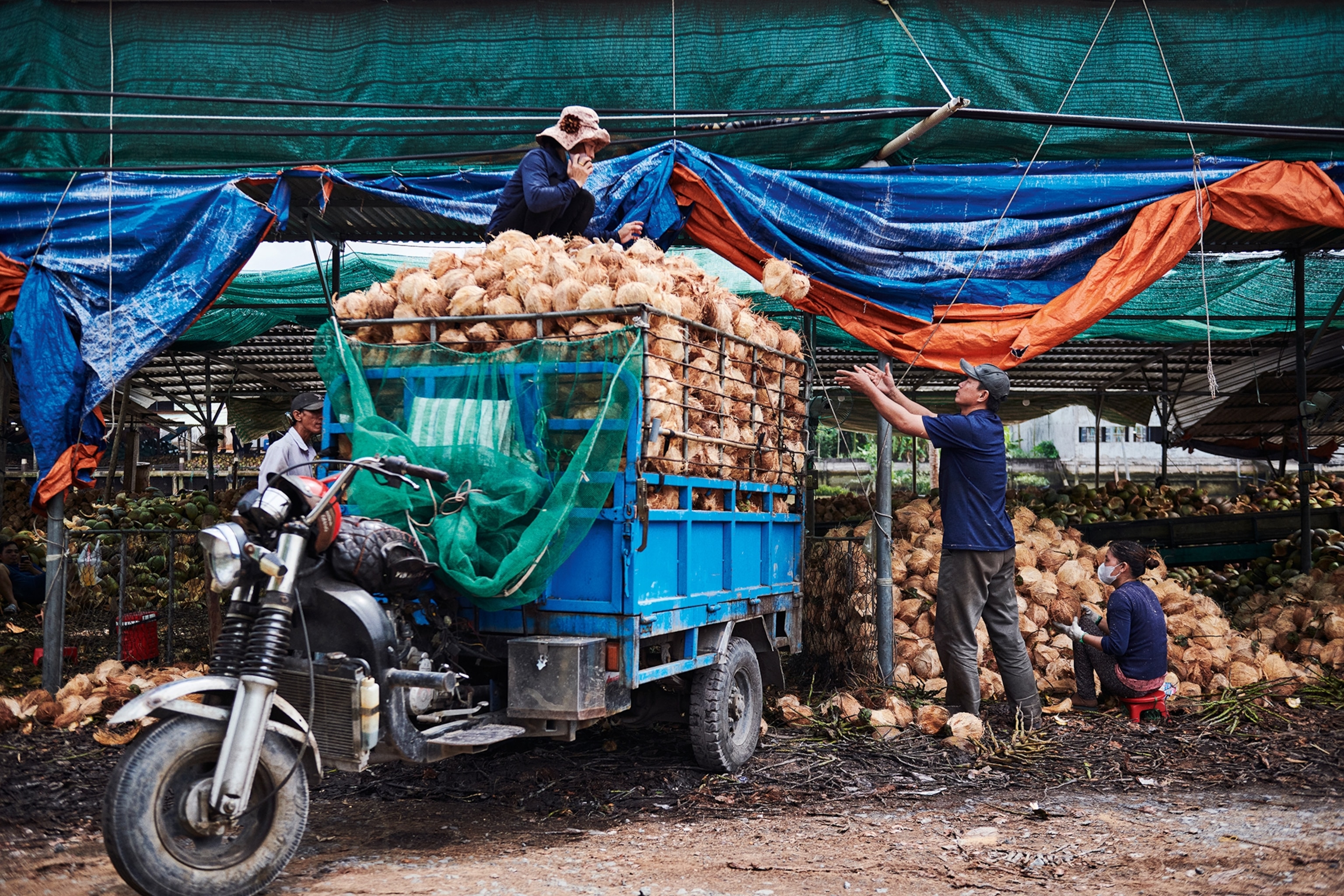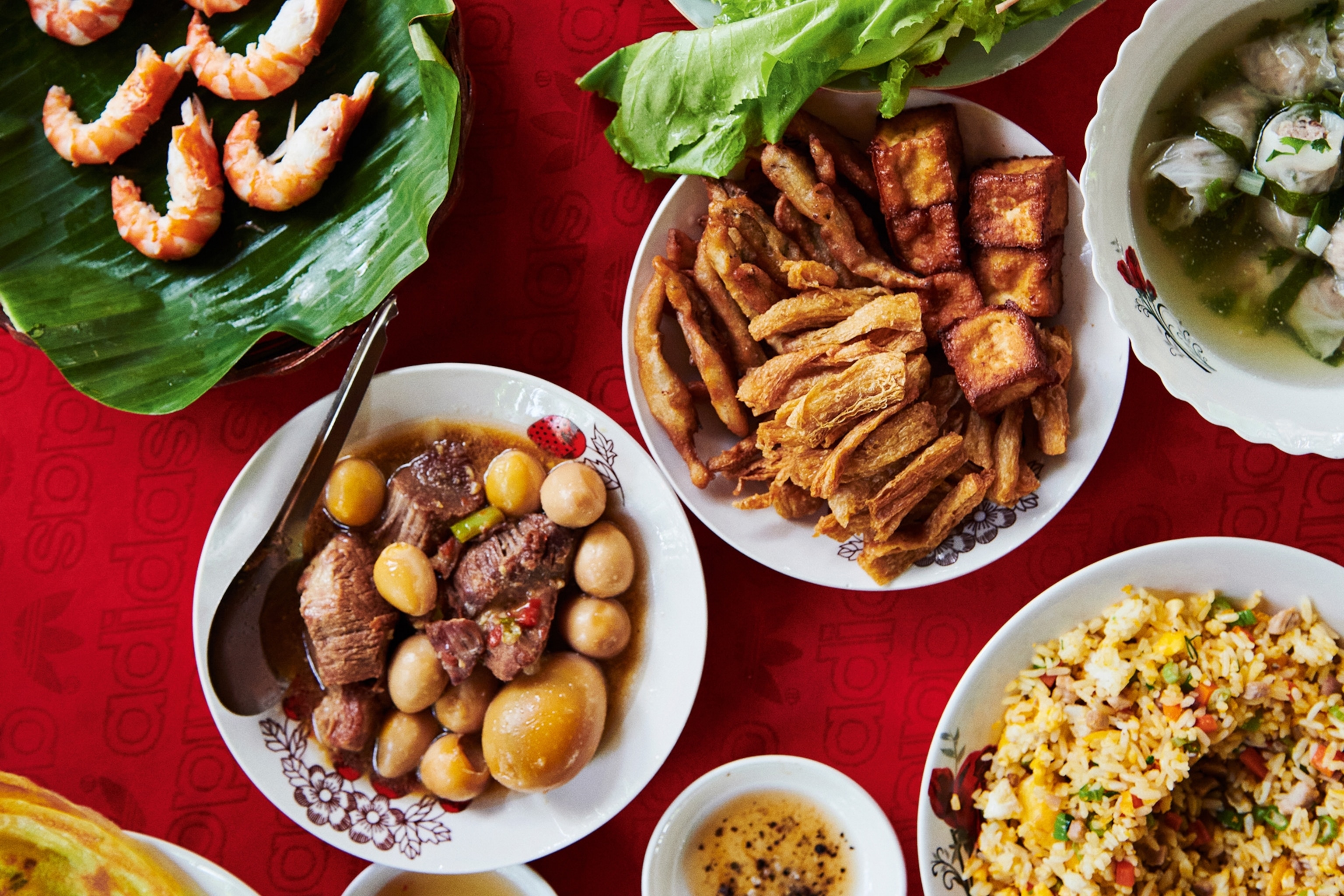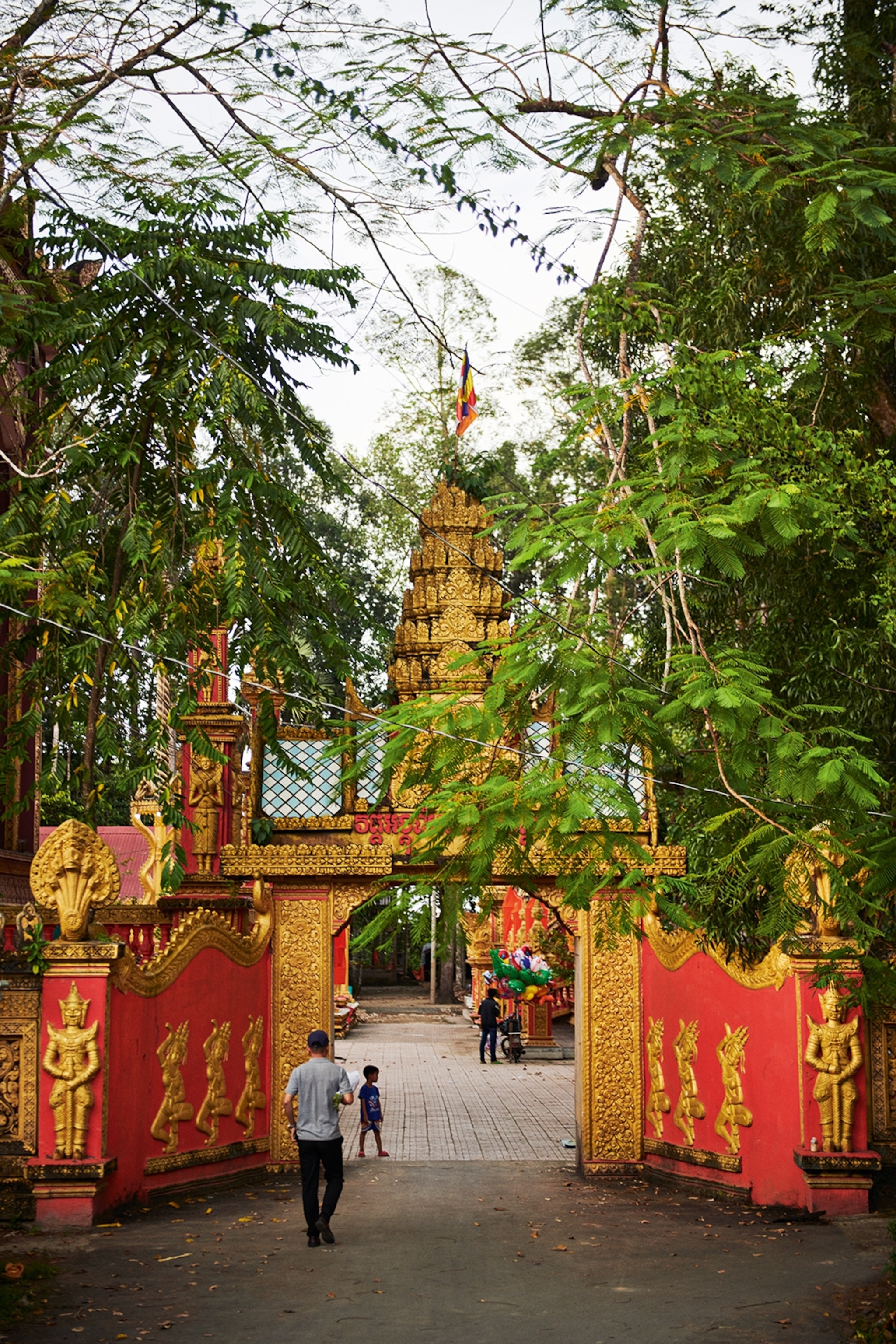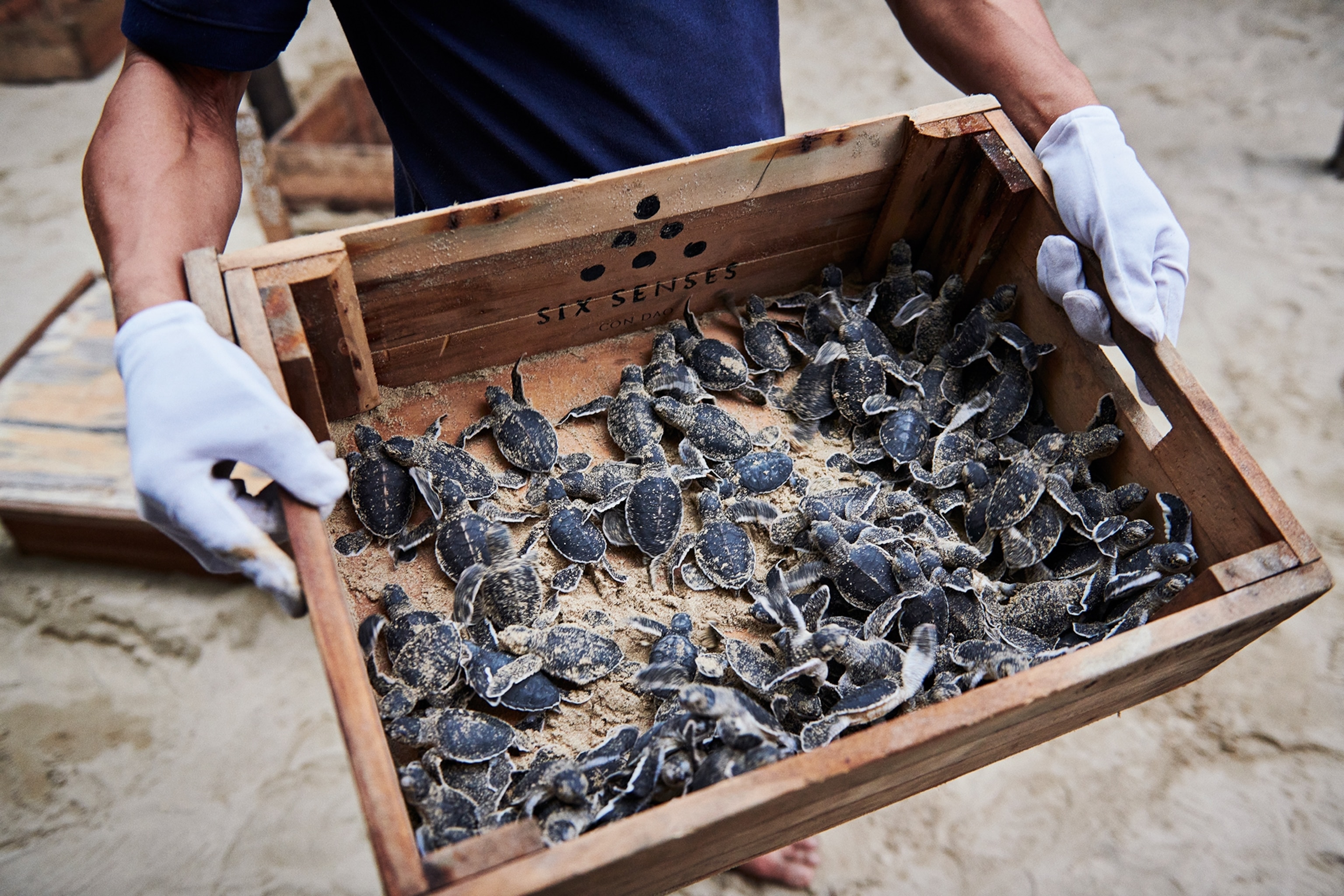A slow journey through Vietnam’s Mekong Delta and Con Dao islands
13 min readThis article was produced by National Geographic Traveller (UK).
The river has eyes. Flashes of blood red and pearly white peer through curtains of coconut palms along the riverbank. Others push through the flotsam and jetsam of the Mekong, breaking up congregations of swollen-stalked water hyacinths and coconut husks borne along by the torpid current. Legend has it that this mighty waterway is ruled by river monsters, but these fiery eyes are painted onto boats — big ones laid low with mountains of coconuts, little ones ferrying fishing traps and fruit farmers cradling jackfruits and durians.
“It’s a tradition of the area to decorate boats like this,” says my guide Jerry Le, baseball cap in hand, his American-inflected drawl lifted onto the breeze that follows in the wake of a large cargo ship passing our open-sided sampan boat. “We believe the eyes are a window to the soul, so by painting the eyes on, they’re giving the boats a soul. Then the boats help protect their owners — especially at night.”
Known locally as the Nine Dragon River, the Mekong has so many limbs that it’s easy to get lost in its anatomy. It writhes for 2,700 miles from China through Myanmar, Laos, Thailand and Cambodia until eventually erupting in Vietnam at its widest point, where I’m sailing its delta for three days. From Ho Chi Minh City, we’d driven two hours south west to a tiny jungle dock at Mo Cay near the point where the river drains into the South China Sea. The plan is to head deeper west into its tributaries to reach the Mekong city of Can Tho.
Boat tours are part of the river’s modern currency and hotels have taken root on its islands, but at heart the Mekong remains an agricultural region. Responsible for a third of Vietnam’s total agrarian output, the delta is the country’s biggest producer of rice, fruit and seafood. Life and water intertwine. Family tombs punctuate the rice paddies that unfold from riverbanks into farms that have been passed down through generations. Fishing communities subsist in pontoon shacks in its tributaries.
In Ben Tre province, where my boat has launched, coconuts are at the heart of life for entire communities. We motor past women hunched in their riverside front yards, husking their harvests with machetes. Open-sided barns are piled high with coconuts ready for processing.

Over 220,000 acres of plantations in Ben Tre produce 600 million coconuts a year. Photograph by Ulf Svane
There are over 220,000 acres of plantations in Ben Tre, producing 600 million coconuts a year. They’re exported as far afield as Japan and South Korea for their water, milk, flesh and fibres, but the riverbanks still resemble a hive of cottage industries.
“Mekong river culture has existed in Vietnam for hundreds of years,” says Jerry. He tells me that although he was raised in Ho Chi Minh City, he grew up visiting family in the Mekong, learning to swim in these tributaries using coconut husks as buoyancy aids, and feasting on coconut flesh as well as spiders, snails and turtles. “The Mekong was a very poor region in the past and people didn’t have many choices on what they ate,” he explains. In recent years, Vietnam’s government has instigated a programme to attract international investors to the Mekong, improving public infrastructure and living conditions, but Jerry says many things remain largely the same. “People do still eat turtle,” he says with a shrug.
Turtle certainly isn’t on the menu for travellers, but it isn’t long before I get to try the province’s ubiquitous coconuts. On the Co Chien River islet of Ho, I find Tan Kiet Nguyen halfway up a palm tree, his toes curled around the trunk as he reaches to twist off the fruit he’ll use to make welcome drinks. He and his wife, Thi Hang Huynh, are one of eight households on the tiny off-grid island that have banded together to diversify their fruit-growing incomes by offering garden tours and meals for visitors. “All the island kids learn to climb coconut palms when they’re around 12,” Thi Hang says, laughing, as I watch Tan Kiet shimmy back down the tree.
As the government pushes for development in the Mekong region, Ho is an example of life pushing against the tide — life is lived off-grid and there are no cars or motorbikes, just earthen paths winding through orchards of ballooning jackfruit and pomelos. Settled a century ago by a couple of farming families, the community has grown to 24 households. My tour of the island’s village weaves between family plots to hammock-strung homes where I sip tea the colour of sapphires, made from butterfly pea flowers; cook crispy ban xeo pancakes stuffed with garden herbs and river prawns; and try fiery bitter-melon rice wine that’s been brewed in a homemade earthenware pot still.

A homemade feast cooked by villagers on Ho, where landslides are drastically shrinking the land. Photograph by Ulf Svane
Ho’s community has grown but the land it lives off has shrunk because of landslides — one reason why the residents are looking for extra income from travellers. The islet isn’t alone in this battle. Land in the Mekong is routinely being eroded. Research from the Mekong River Commission, an intergovernmental body established in 1995 to monitor the region, shows climate change is making the delta increasingly fragile. Around 30% of this 15,560sq-mile region is below sea level and the forecast rise in global sea levels is expected to increase both the salinity and the risk of flooding in Vietnam’s food bowl.
Rural ways
I get to see how closely delta life is intertwined with the water on a bike tour the next day, after a night on an island near the town of My Tho. Miles of durian farms, irrigated by the Mekong, line country roads. Residents fish from porches, French doors flung open to catch the river breeze. Some abandoned brick houses crumble into the flaking banks, wide cracks pulling them apart at the seams.
Not all Mekong communities live so close to the water’s edge. Jerry wants to show me the region’s Khmer villages, deep in the Mekong’s Vinh Long province, two-and-a-half hours west of Ben Tre. Home to a large Khmer community — an ethnic group primarily based in Cambodia — the area contains one of Vietnam’s most spectacular Khmer Buddhist complexes, the Phu Ly 1 temple. It’s a 20-minute walk from the nearest river dock, and the stroll takes us through a village where groups of men lounge in front yards after work, cradling Saigon beer bottles and microphones, waiting for cues from tinny karaoke machines. We’re less than two hours from the Cambodian border, but Jerry says the Khmer presence here has little to do with migration prompted by the civil war that tore apart Vietnam’s neighbour from the late 1960s.
“They came here to build a community in 1653,” he says. “The temple complex was originally built to house the community and protect them from tigers, crocodiles and scorpions.” Only scorpions remain in the Mekong Delta today, but on arrival at the complex, its high walls still give the impression of a fortress. Just behind the blood-red gates is a 20ft-tall golden seated Buddha floating on a lotus, behind which is a series of temple halls, cremation rooms and quarters that sleep up to 200 monks at a time.

The Phu Ly 1 temple is one of Vietnam’s most spectacular Khmer Buddhist complexes. Photograph by Ulf Svane
Vietnamese religious life is complex, often incorporating elements of Taoism, Confucianism, Buddhism, Cao Daoism and, in some areas, Catholicism — the latter largely due to French colonialism. But here at Phu Ly 1, I also spy the eagle goddess Garuda from Hinduism carved into temple walls and stone plinths bearing the three-sided heads made famous by Cambodia’s Angkor Wat. A monk in a turmeric-coloured robe is setting up plastic chairs and 6ft-tall speakers are crackling to life. “Community festival,” explains our host monk with a smile.
We’re soon back on the river, and my final stop that night is the region’s capital, Can Tho — the fifth-largest city in Vietnam, with a population of around 1.3 million. It hasn’t always been so urban. “Ten years ago, Can Tho was just a rural district, but now we have hotels and nightlife,” says Jerry, as our boat enters a water crossroads framed by high-rise hotels. The night-market stalls that line riverside promenades are lighting up like fireflies as dusk descends.
The city’s Cai Rang district is famed for its floating market — a feature of Mekong life for hundreds of years. “Before the road network, everything was done by boat,” says Jerry. Approaching the market from the river the next morning, I notice washing lines hanging outside many of the boats’ small cabins and decks slung with hammocks. “Mobile housing,” says Jerry, nodding to the makeshift living compartments — many of the people working here live permanently aboard their boats.
Long bamboo poles hang from the boats, displaying what’s for sale that day: onion, garlic and pumpkins, along with huge quantities of watermelons roped together. But the collection of sampans here are not exactly the vast floating village I’d read about before my visit. Development means this aspect of Can Tho life is slowly dying out, with more people shopping off the back of motorbikes than boats. “People want to move forward,” says Jerry emphatically, clearly choosing his words carefully. “But we feel really sad that this market probably won’t be here for our kids.”
Welcome to hell
My next stop is the Con Dao archipelago at the very southeastern edge of Vietnam’s borders. Like the Mekong, it’s a region on the brink of change. As my plane comes in to land on the main inhabited island of Con Son, I’m greeted by the sight of a small flotilla of rainbow-coloured trawlers and squid boats, bobbing offshore like a thousand tiny satellite islands. High mountains covered in longan and bang nut trees line one side of the road from the airport while the other overlooks miles of empty beaches. Few tourists make it as far as these islands, but developers are starting to wake up to their potential. Close to the ferry terminal, builders are clearing seafront palms to sink concrete foundations for new resorts.
Even 30 years ago, it would have been unthinkable to have hotels on the island. “Con Dao used to be called ‘hell on Earth’,” says my young guide Thi Nhuan ‘Pumpkin’ Nguyen later that day. Wearing white trainers and a traditional conical hat, she leads me down quiet backstreets in Con Son town, where grand villas recall its French 19th-century colonists. Our destination is a notorious prison nicknamed the Tiger Cages — one of several built to house dissidents between 1887 and 1954, when Vietnam was part of French Indochina. In the 1950s, the prisons were inherited by the Americans during the Vietnam War. Now they’re protected as a national monument.
We enter Phu Tuong prison to find the air inside still and stale, the walls slick with mildew. Pumpkin’s father, born in 1959, might have ended up here if things had been different. “When he was young he was called to fight in Con Dao with the resistance, but he was an only son and my grandmother didn’t want him to go,” she explains as we ascend a flight of stairs to a platform above a row of open-roofed concrete pens. Info boards describe how prison guards used the vantage point to throw a concoction of limestone and water into cells, gluing prisoners so they couldn’t move.
Many Vietnamese were less fortunate than Pumpkin’s dad. Fighters from all over the country went missing behind Con Dao’s palm-flanked shores when the town was used as a base for interrogation, imprisonment and execution by the French and then Americans. At Hang Duong cemetery, I find 2,000 tombs — half of them unnamed, simply embossed with the five-pointed yellow star of the national flag. The mood among the crowd of Vietnamese visitors, however, is surprisingly festive. For this is the resting place of Vo Thi Sau, a national hero who’s become synonymous with the islands.
Aged 14, Vo Thi Sau joined the growing guerrilla movement against French occupation. It was the 1940s and Vietnam was part of French Indochina. Eventually captured and convicted, at the age of 19 she became the first woman to be executed on Con Dao — three years before the start of the Vietnam War that ravaged the country until 1975. This grim fate has led Con Dao to become a pilgrimage site for thousands of Vietnamese each year.
Despite the cemetery’s size, Vo Thi Sau’s grave is easy to find, surrounded by a throng of people. Decorated like a shrine with her sepia portrait at the centre, it’s lit by incense, festooned with chrysanthemums and piled with paper offerings in the form of mock handbags, combs and jewellery sets — all the accoutrements of young womanhood she might have enjoyed had her life taken a different course. “We admire her courage,” says one young woman mourner when I ask why she’s come. “She’s the spirit of the island.”
A brighter future
Today, about a fifth of the island’s inhabitants are still military, but Con Dao sees its future in nature tourism. Dirt tracks used only by hikers and the occasional motorbike taxi take me across the spine of the island to deserted pebble coves inhabited by shy black squirrels. One morning, I go clam collecting with a metal pail and an island guide, watching crabs skate across the sands as we trawl the beach with a bamboo rake. On a pontoon restaurant reached by boat, I eat Con Dao squid and crab fished out of open sea nets.
They may be eaten elsewhere but here turtles are the focus of conservation efforts. Little was known about their movements around the islands until 2017, when staff from the Six Senses eco-lodge on Con Son island’s east coast discovered a female green turtle had come ashore to lay a clutch of eggs. The lodge immediately applied for a licence to run a turtle conservation programme and in 2018 became the only private-sector hotel in Vietnam authorised to help protect this 200-million-year-old species.
As luck would have it, I’ve arrived on Con Dao just as the final eggs of the season are hatching. “Normally, places where turtles lay their eggs have to be pristine. A mother turtle came to this beach six times this year, which is very good,” explains Jun Nishimura, Six Senses’ assistant sustainability manager. He leads me down wooden boardwalks beneath a dense jungle canopy to the lodge’s mile-long swathe of sand. The hotel monitors the nesting with 24-hour beach cameras and the aid of local fishermen.

A clutch of baby green turtles awaiting release to the ocean. Photograph by Ulf Svane
To improve the turtles’ chance of survival, they relocate egg clutches to a sheltered incubation zone that mimics their natural nest conditions. When I visit, I find a swarm of palm-sized baby turtles. “It’s a one in 1,000 chance of survival if left to nature,” Jun explains. While island tides, storm patterns, predators and fluctuating temperatures can interfere with nesting grounds, ocean plastics and fishing nets also await the hatchlings that make it to the sea. Although the islands are a national park, the protected zone doesn’t extend to the marine environment where the local communities fish.
The turtles’ first steps will biologically imprint them with this beach’s location, drawing the females back when it comes to laying their own eggs. “So far this year, we’ve had an 89% success rate with hatchlings, but it’s difficult to know what the survival rate is because they’re so small we can’t tag them,” explains Jun. “We will only know in 25 to 30 years’ time, if we see a mother return to this beach.”
Once the hatchlings are transferred to the beach by trained handlers, we wait. “They’re programmed to go to the ocean,” says Jun, his bare feet in the surf, a nervous grin on his face. The baby turtle nearest my feet pauses, flippers wiggling as if testing the breeze. Nature works its magic and it’s off. “Good luck buddy!” calls Jun, as we watch the tiny creature propel itself in an ungainly manner across the sand. If it’s anywhere near as resilient as the other locals around these southern waters, I’ve no doubt it’ll be back.
Brits can travel in Vietnam for up to 45 days visa-free under the country’s new visa waiver system. InsideAsia has an 11-night southern Vietnam itinerary from £3,300 per person. It includes four nights in Ho Chi Minh City, three nights in the Mekong Delta and four at Six Senses on Con Dao, some meals, all transport, some private guiding and activities, but excludes international flights.
When to go:
November to February is the best time to visit southern Vietnam, with comfortable humidity and fewer downpours. In the Con Dao islands, turtle-hatching season is from August to November. Temperatures don’t vary significantly in southern Vietnam, with daytime highs in the mid- to late-20Cs. The southern monsoon season runs May to October.
Getting there & around:
Vietnam Airlines flies direct to Ho Chi Minh City from Heathrow, and offers multiple daily departures to the Con Dao islands from Ho Chi Minh City and Can Tho in the Mekong. Carriers including Singapore Airlines and Thai Airways also fly to Ho Chi Minh City with a stop The average flight time is 14 hours. To explore the Mekong Delta, you’ll need to use boats, taxis and hotel shuttles. Con Dao has taxis and motorbikes to hire.
Where to stay:
The Island Lodge, Mekong Delta. From VND5.8 million (£185), B&B.
Azerai Can Tho, Mekong Delta. From £185, B&B.
Six Senses Con Dao. From £915 a night, B&B.
This story was created with the support of Inside Asia and Vietnam Airlines.
To subscribe to National Geographic Traveller (UK) magazine click here. (Available in select countries only).



